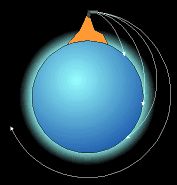
Home - Search - Browse - Alphabetic Index: 0- 1- 2- 3- 4- 5- 6- 7- 8- 9
A- B- C- D- E- F- G- H- I- J- K- L- M- N- O- P- Q- R- S- T- U- V- W- X- Y- Z
Newton's Orbital Cannon
 Newton's Cannon |
Imagine a mountain so high that its peak is above the atmosphere of the earth. Imagine on top of that mountain a cannon, that fires horizontally. As more and more charge is used with each shot, the speed of the cannonball will be grater, and the projectile will impact the ground farther and farther from the mountain. Finally, at a certain speed, the cannonball will not hit the ground at all. It will fall toward the circular earth just as fast as the earth curves away from it. In the absence of drag from the atmosphere, it will continue forever in an orbit around the earth.
Status: Design 1687.
This was the first and best explanation of what an orbit is. An object in orbit is weightless not because 'it is beyond the earth's gravity' but because it is in 'free-fall' - just like a skydiver. The difference is that it has enough horizontal speed never to hit the ground.
Although Newton did not intend this to be a practical proposal, the example was certainly known to all who would later dream of the 'shot into infinity'....
Family: Gun-launched, orbital launch vehicle. Country: UK. Bibliography: 47.
Back to top of page
Home - Search - Browse - Alphabetic Index: 0- 1- 2- 3- 4- 5- 6- 7- 8- 9
A- B- C- D- E- F- G- H- I- J- K- L- M- N- O- P- Q- R- S- T- U- V- W- X- Y- Z
© 1997-2019 Mark Wade - Contact
© / Conditions for Use